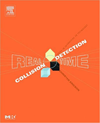Endorsement quotes
"Accurate and efficient collision detection in complex environments is one of the foundations of today's cutting-edge computer games. Yet collision detection is notoriously difficult to implement robustly and takes up an increasingly large fraction of compute cycles in current game engines as increasingly detailed environments are becoming the norm. Real-time Collision Detection is a comprehensive reference on this topic, covering it with both breadth and depth. Not only are the fundamental algorithms explained clearly and in detail, but Ericson's book covers crucial implementation issues, including geometric and numeric robustness and cache-efficient implementations of the algorithms. Together, these make this book a 'must have' practical reference for anyone interested in developing interactive applications with complex environments."
—Matt Pharr,
Senior Software Developer, NVIDIA
"Christer Ericson's Real-time Collision Detection is an excellent resource that covers the fundamentals as well as a broad array of techniques applicable to game development."
—Jay Stelly,
Senior Engineer, Valve
"Christer Ericson provides a practical and very accessible treatment of real-time collision detection. This includes a comprehensive set of C++ implementations of a very large number of routines necessary to build such applications in a context which is much broader than just game programming. The programs are well-thought out and the accompanying discussion reveals a deep understanding of the graphics, algorithms, and ease of implementation issues. It will find a welcome home on any graphics programmer's bookshelf although it will most likely not stay there long as others will be constantly borrowing it...."
—Hanan Samet,
Professor of Computer Science, University of Maryland
"Real-Time Collision Detection is an excellent resource that every serious engine programmer should have on his bookshelf. Christer Ericson covers an impressive range of techniques and presents them using concise mathematics, insightful figures, and practical code."
—Eric Lengyel,
Senior Programmer, Naughty Dog
"If you think you already know everything about collision detection, you're in for a surprise! This book not only does an excellent job at presenting all the collision detection methods known to date, it also goes way beyond the standard material thanks to a plethora of juicy, down-to-earth, hard-learned implementation tips and tricks. This produces a perfect blend between theory and practice, illustrated by the right amount of source code in appropriate places. Basically the book just oozes with experience. Christer doesn't forget all the alternative topics that, despite not directly related to collision detection, can ruin your implementation if you don't include them in your design. The chapters on robustness and optimization are priceless in this respect. Its carefully crafted compact kd-tree implementation beautifully concludes a unique book full of luminous gems."
—Pierre Terdiman,
Principal Software Engineer, NovodeX AG
(author of the OPCODE collision detection library)
"When I received a copy of Real-Time Collision Detection for review, I was in the midst of redesigning an architectural visualization and lighting design program. The Bounding Volume Hierarchies chapter allowed me to quickly and easily design and implement an efficient ray tracing acceleration scheme. It also provided me with a wealth of information on various design strategies, which gave me the confidence that I had chosen a near-optimal approach. What one of my clients recently said about the finished software reflects my opinion of this fantastic book: 'Holy cow! Excellent work!'"
—Ian Ashdown,
President, byHeart Consultants Limited
"Solid theory coupled with the author's own practical experience makes this book
an excellent choice for practitioners in the field. In addition to describing a
wide range of relevant algorithms, the author also discusses optimization, numerical
precision, robustness, and other topics critical in creating a workable interactive
system."
—Eric Haines,
Lead Software Engineer, Autodesk
